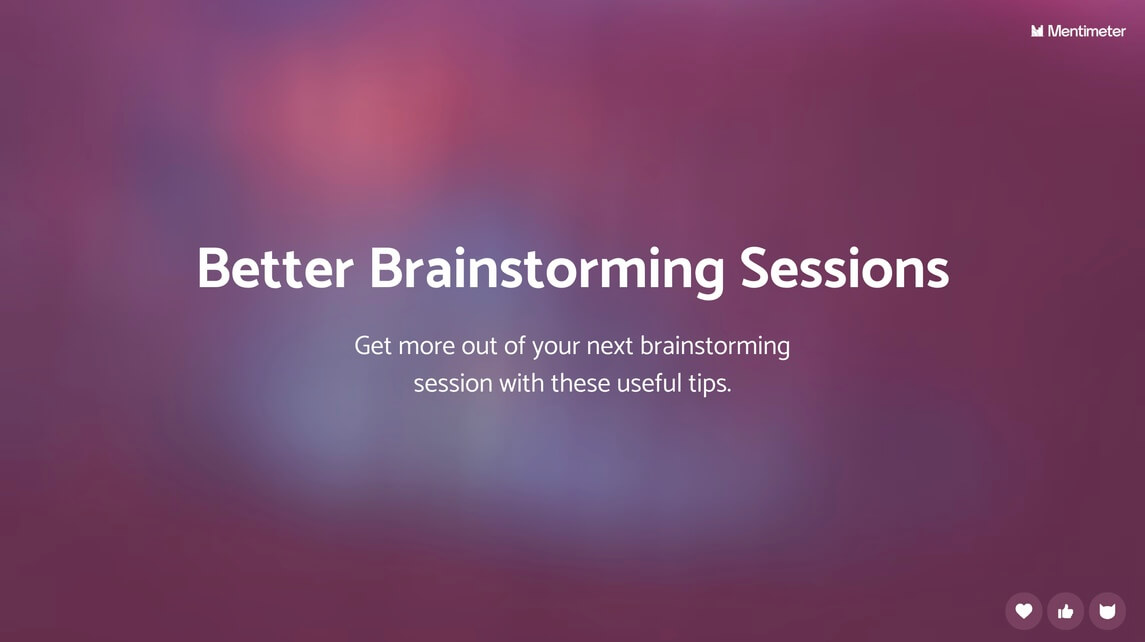Conducting a brainstorming session is a quick and innovative way to generate fresh ideas and gather a variety of different perspectives. A little added thought and structure will help ensure that your next brainstorming session is as effective and beneficial as possible for you, your team, and your organisation.
When done correctly, group brainstorming sessions have the power to gather a wide variety of ideas, uncover some hidden gems, and help develop some half-baked ideas. But oftentimes, brainstorming sessions can become dominated by one voice, discussions may become unfocused, and awkward silences develop from a fear of sharing in front of others.
Mismanaged or done incorrectly, brainstorming can, at best, be a frustrating and unfulfilling experience, and at worst a drain on time and resources. But thankfully there are several ways that we can safeguard against those pitfalls and drawbacks.
What is brainstorming?
This might seem like a redundant question but it is surprising how often people confuse a brainstorming session for something else like a workshop, a focus group, or a group discussion. Remember that brainstorming is gathering together ideas to solve a particular problem or as a way to compile new innovative ideas.
As well, this is a group effort and while many of us may prefer to generate ideas on our own, the benefit of listening to others share their ideas is that it can trigger further insightful ideas and future discussions and debates that lead to collaborative solutions.
This is not the place to hone in on one specific thought and to endlessly bat it back and forth -. that is for another time and place. This session should be entirely focused on idea generation and some elements of idea building. Brainstorming, therefore, is most effective when run in conjunction with workshops, follow-up meetings, and reviews. This is something we will touch upon later.
Ways to improve brainstorming
As the title of this post indicates, we’ve put together a series of best practices that can help you get the most out of a brainstorming session, as well as help you avoid some common mistakes we often see managers and team leads make.
1. Create a good environment for sharing
2. Set a focus
3. Make participating easier
4. Prepare for success
5. Break it up
6. Revisit and review
Create an environment conducive to sharing
It is impossible to stress just how important this element is. Gathering ideas is something that many can do without issue or problem, but the idea of sharing these thoughts with others can be a massive stumbling block. Evaluation apprehension is an obstacle that good brainstorming sessions will look to mitigate and avoid. Thankfully there are many tools out there that will allow participants to submit responses anonymously.
Perhaps they think their idea is too “out there”, or maybe they’re just worried about being judged for what they will or won’t say. One way to circumvent this problem, and to encourage everyone to participate, is to allow for anonymous participation. Gathering countless ideas will be much easier if people can do so in confidence without the pressure of having to speak on their own in front of others. Less fear of judgment means more engagement and a greater willingness to speak up.
Furthermore, even as things begin to unfold, many will still hold back from contributing, feeling that what they have to say will not be taken seriously, or dismissed altogether. For this reason, it is crucial to foster an environment of inclusivity where everyone feels comfortable.
Your brainstorming session should thus be free of criticism and critique all the while assuring people that even if they think that their idea may not be “good enough”, it can be developed later on by the group, and others can help to refine and develop it. The goal shouldn’t be to critique ideas and to point holes; it should be to think creatively and gather a wide range and variety of unique opinions.
Set a focus
It is important to begin by setting a goal for the session so the group has a result to work towards; too broad a focus may run the risk of a list of great ideas that don’t help solve any one issue, too narrow and the group may struggle to generate a satisfactory amount of ideas.
This simple step can have the added benefit of instilling the group with a sense of accomplishment when the brainstorming session is over. Likewise, it will make planning follow-up meetings all the easier.
It is important that you walk into every single brainstorming session with a specific goal or problem in mind, not just have it be an idea free-for-all. Finding a good balance between overly broad and overly specific will greatly help both idea generation and people’s ability to focus on finding innovative solutions and pertinent ideas.
Make it easy to take part
We spoke earlier about creating an environment that is conducive to freely sharing ideas; in many ways, this is a prerequisite for improving participation. Naturally, people will be more inclined to take part if they feel that their ideas will be taken seriously and that those around them will listen and consider what they have to say. But what can you do from a technical perspective to make participating all the easier?
To do this you will need to have a system in place that gives everyone an equal voice in the discussions, can handle multiple submissions with ease, and displays everyone’s ideas in a clear and concise manner. Some countless tools and softwares can make a meeting more efficient than the traditional pen and paper method. Likewise, a number of these tools will make it easier to save and share everything once the meeting has ended. Finding the right one that works best for your team will make the meeting both more efficient and inclusive.
Arrive prepared
Coming up with things on the spot isn’t easy, nor is it time-efficient, and this is one of the common downfalls of brainstorming sessions. Clarifying the goal beforehand is step one. Step two should be arranging some prep work so your team can arrive brimming with ideas. Consider offering them a way to submit ideas before the meeting begins, this way you can all benefit from individual brainstorming while jumping right into the insights.
Asking participants to prepare something beforehand can also help safeguard against awkward silences, as everyone will be arriving already in a creative mindset. That being said, there can also be benefits to spontaneity in brainstorming sessions, so use this to your advantage by diving deeper into responses by asking everyone to pick out an idea they find particularly fascinating.
Break it up
Brainstorming sessions, and thinking creatively in general, can require quite a lot of energy. Shorter blocks within meetings will help to prevent the group from losing energy or motivation during the session. The goal should be to run as productive a meeting as possible, thus, if you think you may need a longer amount of time to get through everything, perhaps consider breaking sessions up so everyone can stay focused and motivated.
Remember that, it is okay to take note of the suggestions worth discussing but leave them for another time, you can even schedule a follow-up meeting with your team member to dive into these suggestions further. We’ve written a whole blog post on how to make your team efficient, which you can read more about here: How to make your team more efficient.
Speaking of which, let’s follow up on that exact idea...
Follow up
An idea is just an idea unless you act on it. Once you have compiled everyone's thoughts and opinions, the last step to seal the deal would be to develop them, turn them into actionable steps, and then implement them. One of the biggest pitfalls about brainstorming meetings is that all those great ideas just sit somewhere collecting dust and cobwebs.
Brainstorming works best when it is run in conjunction with further meetings down the road - like a workshop or a focus group - where the focus is no longer on generating ideas but putting them into practice, making plans, assigning responsibilities and duties.
Make it a habit to assign action items at the end of each brainstorming meeting. It could be as easy as assigning people to lead the project or scheduling meetings with the member who suggested the idea to find out more. Ultimately, you and your team should leave the meeting with some point of action or further discussions.
Better brainstorming means better outcomes
Setting a goal and following up on the implementation of our ideas is an easy way to make your next brainstorming session more effective. Fostering an inclusive environment and inviting participants to engage anonymously can help to ensure no ideas go unexpressed. And encouraging your team to prepare beforehand can help ensure they come armed with great ideas to propel your organization forward.
Mentimeter can at the same time both enable individual work and create a base for discussions between team members. It is quick to set up, anonymous, and easy to use on any online device - helping you create a productive brainstorming session! To get started download out ready-to-use project brainstorm template here!

Project Brainstorming Session



